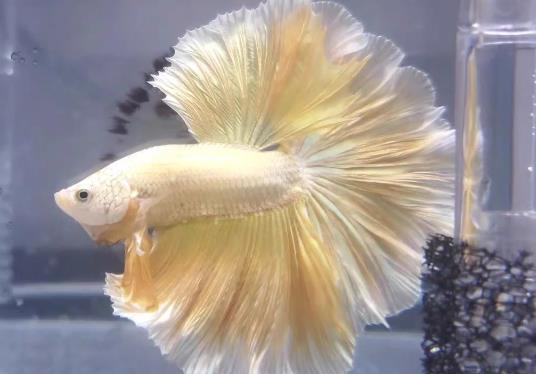When your betta fish shows signs of poor health, it’s crucial to identify symptoms promptly and take the right treatment measures. Below is a comprehensive care guide for sick bettas, including disease identification, treatment plans, and care recommendations during the recovery period.

1. Identifying Symptoms of Common Betta Fish Diseases
1.1 General Disease Warning Signs
Abnormal Behavior: Slow swimming, lethargy, or unusual floating/sinking (e.g., staying at the water surface or resting on the tank bottom).
Color Changes: Sudden dulling of color, turning pale white, or darkening of the body.
Respiratory Issues: Increased breathing rate or frequent surfacing to gasp for air.
Loss of Appetite: Losing interest in food or refusing to eat entirely.
Abnormal Waste: White, stringy feces or changes in the color/consistency of waste.
Eye Problems: Swollen eyes, excessive discharge, or cloudy vision.
Fin Abnormalities: Torn, clamped, or fused fins.
Skin Lesions: Red spots, blisters, or open ulcers on the body.
1.2 Symptoms of Specific Diseases
Ich (White Spot Disease): Dense white spots (resembling grains of salt) across the body; the betta appears lethargic or irritable.
Water Mold (Saprolegniasis): Cotton-like, fuzzy growths on the body or fins; the betta’s color fades significantly.
Enteritis (Gastrointestinal Disease): Loss of appetite, white stringy feces, and a swollen abdomen.
Clamped Fin Syndrome: Fins remain tightly closed (as if glued together) instead of spreading normally.
Fin Rot: The edges of fins look ragged, frayed, or “burnt”; tissue may appear discolored (gray/brown).
Dropsy (Swim Bladder & Scale Disease): Scales stand upright (resembling a pinecone); excessive mucus secretion on the body.
2. Treatment Plans for Common Diseases
2.1 Treating Ich (White Spot Disease)
Temperature Raising Method: Gradually increase the water temperature to 30°C (86°F) at a rate of no more than 3°C (5.4°F) per day; maintain this temperature for 3–5 days to kill ich parasites.
Salt Bath: Add aquarium-specific salt or coarse sea salt to the water, keeping the concentration between 0.3% and 0.5% (3–5 grams of salt per liter of water).
Medication: Use a methylene blue solution for immersion (follow the product’s dosage instructions carefully to avoid overdosing).
Supportive Measures: Increase water oxygenation (e.g., use an air stone) to boost the betta’s metabolism during treatment.
2.2 Treating Water Mold
Water Change: First, replace 50% of the tank water with well-aerated, dechlorinated new water.
Temperature Adjustment: Raise the water temperature to 30°C (86°F) to inhibit mold growth.
Heavy Salt Treatment: Add salt to reach a concentration of approximately 0.5% (5 grams per liter of water).
Medication: Use kanamycin (often sold as “yellow powder”) or oxytetracycline. After 2–3 days, perform a partial water change and replenish the medication.
Severe Cases: For advanced mold growth, use gentamicin sulfate or methylene blue (follow dosage guidelines strictly).
2.3 Treating Enteritis
Bacterial Enteritis
Stop feeding the betta for 1–2 days to rest its digestive system.
Raise the water temperature by 2°C (3.6°F).
Add medication: Use 3 tablets of oxytetracycline and 6 tablets of furazolidone per 100 liters of water.
After 2 days, perform a partial water change and add a fresh dose of medication.
Parasitic Enteritis
Treat with a specialized anti-parasitic medication (e.g., products containing praziquantel or levamisole).
Supplement with anti-parasitic fish food to target internal parasites.
Supportive Therapy: A mild garlic water soak (dilute crushed garlic in tank water) can help soothe the digestive tract.
2.4 Treating Other Common Diseases
Clamped Fin Syndrome: Raise the water temperature by 2°C (3.6°F), add a small amount of coarse salt, and replace 1/4 of the water with fresh, dechlorinated water daily.
Fin Rot: Stabilize water quality first; use a bactericidal solution or kanamycin (“yellow powder”) to prevent secondary infections.
Fin/Tail Ulcers or Pinholes: For bacterial causes, treat with kanamycin; for parasitic causes, use a trichlorfon bath (follow product instructions).
Velvet Disease (Oodinium): Replace 50% of the water, raise the temperature to 30°C (86°F), and add a heavy salt dose (0.5% concentration).
3. Special Care Tips During the Sick Period
3.1 Water Quality Management
Keep water clean by maintaining regular water changes (you may increase the frequency slightly during illness).
Use “old water” from the original tank when setting up a quarantine tank—this reduces stress from sudden water parameter changes.
Avoid drastic fluctuations in pH, temperature, or ammonia/nitrite levels.
3.2 Temperature Control
Keep the water temperature stable; avoid differences larger than 2°C (3.6°F) within a 24-hour period.
Slightly raise the temperature (as recommended for specific diseases) during treatment—it helps boost the betta’s immune system.
3.3 Feeding Adjustments
Stop feeding the betta for 1–2 days if it has a severe illness (e.g., advanced enteritis).
During recovery, feed easily digestible, high-protein foods (e.g., frozen brine shrimp or specialized recovery pellets).
Control portion sizes strictly—any uneaten food will rot and pollute the water, worsening the betta’s condition.
3.4 Quarantine Measures
Isolate the sick betta in a separate quarantine tank to prevent the spread of disease to other fish (if applicable).
Disinfect the original tank and all equipment (e.g., nets, filters) with a mild bleach solution (then rinse thoroughly) to kill residual pathogens.
3.5 Environment Optimization
Provide a quiet environment with soft, indirect lighting—bright light or loud disturbances can increase the betta’s stress.
Minimize handling or tank maintenance (only essential tasks) to reduce stress, which hinders recovery.
Add Indian almond leaves to the water—they release natural tannins that help stabilize water quality and have mild antibacterial properties, supporting the betta’s healing.
